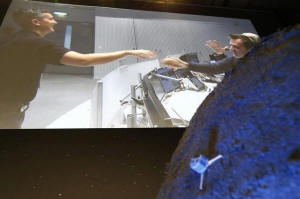|
 Scientists
bid comet lander Philae farewell after radio silence Scientists
bid comet lander Philae farewell after radio silence
 Send a link to a friend
Send a link to a friend
[February 12, 2016]
By Maria Sheahan
FRANKFURT (Reuters) - European scientists
have given up hope of restoring contact with space probe Philae, which
successfully landed on a comet in a pinpoint operation only to lose
power because its solar-driven batteries were in the shade.
|
|
 The German Aerospace Center (DLR) said on Friday it suspects
Philae is now covered in dust and too cold to operate. The German Aerospace Center (DLR) said on Friday it suspects
Philae is now covered in dust and too cold to operate.
"Unfortunately, the probability of Philae re-establishing contact
with our team at the DLR Lander Control Center is almost zero, and
we will no longer be sending any commands," Stephan Ulamec, Philae
Project Manager of the DLR, said in a statement.
Philae came to rest on a comet in November 2014 in what was
considered a remarkable feat of precision space travel. But it
closed down soon after because it was in the shade and could not be
recharged.
The probe woke up in June as the comet approached the sun, giving
scientists hope that the lander could complete some experiments that
it had not done before its solar-powered batteries ran out.
 But the lander has not made contact with its Rosetta orbiter since
July 9, and a last-ditch attempt to re-establish contact with the
robotic lab has failed.
"It would be very surprising if we received a signal now," Ulamec
said.
While the project team believes that Philae is likely ice-free, the
solar panels that recharge its batteries are probably covered with
dust.
In addition, night-time temperatures can now fall below 180 degrees
Celsius below zero (-292°F) as comet 67P/Churyumov-Gerasimenko moves
away from the sun, which is much colder than Philae was designed to
withstand.
[to top of second column] |

While Philae did not have as much time as initially hoped after
landing for experiments, information it has collected is reshaping
thinking about comets, and it has been a useful lesson for designing
future missions.
Scientists expect to get a final glimpse of the lander in the
European summer, when the Rosetta spacecraft snaps some pictures
during close fly-bys, before landing on the comet itself when its
mission ends in September.
And in around six years, Philae and Rosetta will near the Earth
again when the comet returns to circle the sun again.
Rosetta is a mission of the European Space Agency, with
contributions from its member states and U.S. space agency NASA. The
Philae lander was provided by a consortium headed by the DLR.
(Editing by Jeremy Gaunt)
[© 2016 Thomson Reuters. All rights
reserved.]
Copyright 2016 Reuters. All rights reserved. This material may not be published,
broadcast, rewritten or redistributed.
 |